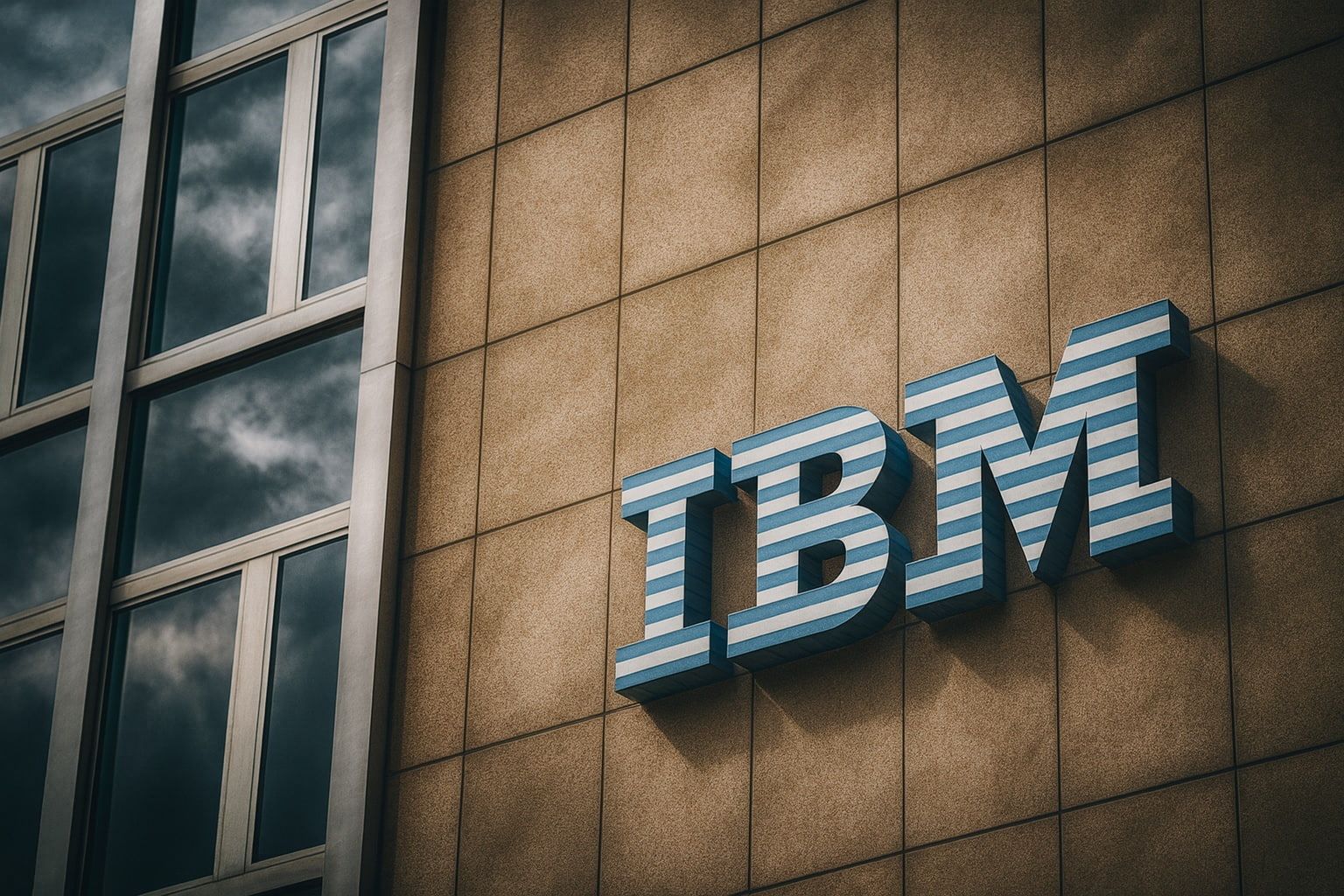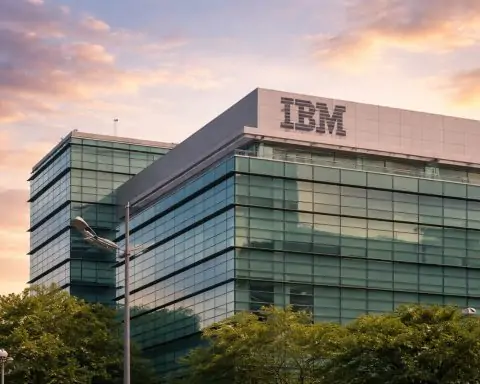- Strong Year‑to‑Date Rally: IBM shares have jumped about 30% in 2025. On Oct. 22 the stock closed around $287.57, though it slid roughly 6.5% in after-hours trading after earnings.
- Q3 Earnings Beat: In the third quarter IBM reported revenue of $16.33 billion (+9% year‑over‑year) and adjusted EPS of $2.65, both topping analyst forecasts. Management raised its full‑year revenue and free cash flow guidance (to >5% revenue growth on a constant‑currency basis) based on this performance.
- AI and Mainframe Growth: AI demand helped drive IBM’s results. The software/AI segment grew ~10%, with automation software up ~22–24%. The new IBM Z mainframe (z17) saw a 61% jump in sales, as financial clients used it to handle AI workloads securely. IBM’s “GenAI book of business” is now about $9.5 billion (up ~$2 billion from Q2).
- Strategic Partnerships: IBM announced several AI and cloud deals in recent weeks. It will offer Groq’s ultra‑fast AI inference chips in its watsonx platform. It teamed up with Anthropic to embed the Claude language models in IBM development tools. In India, IBM is bringing Power10 AI servers and Red Hat OpenShift to Bharti Airtel’s cloud service. At its Oct. 2025 TechXchange event IBM also launched new AI management and security tools (like “AgentOps” for AI agents and a quantum‑safe Guardium manager) and an AI accelerator (“Spyre”) for its z‑series mainframes [1].
- Analyst Commentary: Wall Street is divided on IBM’s outlook. Some worry that the stock has run up too far. Synovus Trust’s Dan Morgan warned the shares are now “priced to perfection” after such strong gains. Others remain optimistic: Wedbush’s Daniel Ives (a longtime IBM bull) maintained an Outperform rating and a $325 price target, noting IBM delivered “solid metrics with AI front and center”.
IBM’s headquarters in Armonk, N.Y., is at the center of the company’s growing focus on AI and cloud computing. In late October 2025, the stock was trading in the high $200s (about $287/share on Oct. 22) after strong third‑quarter results. The 2025 rally (up ~30% YTD) reflects renewed investor enthusiasm under CEO Arvind Krishna’s strategy, but the after‑hours selloff shows that even good news can trigger profit‑taking.
In its Oct. 22 earnings release (Q3 FY2025), IBM reported revenue of $16.33 billion, up 9% from a year earlier. Adjusted net income was $2.5 billion, or $2.65 per share, ahead of Wall Street targets. All three business segments grew: Software (including Red Hat) was $7.2 billion (+10%), driven by 24% growth in Automation software; Consulting was $5.3 billion (+3%); and Infrastructure (hardware) was $3.6 billion (+17%), led by the new IBM Z mainframe up 61%. CEO Arvind Krishna highlighted that the company’s “AI book of business” now exceeds $9.5 billion, and CFO James Kavanaugh said “new innovation, the strength and diversity of our portfolio, and our disciplined execution” delivered the upside. IBM raised its full‑year outlook to more than 5% revenue growth at constant currency, and expects about $14 billion in free cash flow (up from a prior $13.5 billion target) for 2025.
IBM has been investing heavily in AI, hybrid cloud and security as growth drivers. This year it completed the $6.4 billion purchase of HashiCorp (for cloud automation tools) and has doubled down on partnerships. In October it announced a deal with chip maker Groq to integrate Groq’s inference cards into IBM’s watsonx Orchestrate AI platform, promising “5X performance at 20% of the cost,” as IBM software chief Rob Thomas put it. IBM also is embedding Anthropic’s Claude AI models into new enterprise development tools, aiming to boost developer productivity with AI (IBM says 6,000 internal developers are already seeing ~45% faster coding using the new tools). In cloud computing, IBM expanded its reach into India by partnering with Bharti Airtel to bring IBM’s Power10 AI servers and Red Hat OpenShift to Airtel Cloud customers. Meanwhile, at its TechXchange 2025 conference IBM unveiled next‑generation offerings: for example, “AgentOps” to orchestrate enterprise AI agents, a Guardium Cryptography Manager to secure data and keys, and a new “Spyre” AI accelerator co‑processor for IBM Z mainframes that will be available on Oct. 28 [2]. These initiatives reinforce IBM’s strategy of helping large businesses run AI workloads securely in hybrid cloud environments.
Analysts have mixed takes on IBM’s prospects. Investors cheered the earnings beat and guided‑up forecasts, but some worry any hiccup could hit the richly valued stock. Reuters quotes Michael Ashley Schulman of Running Point Capital saying that slower growth at Red Hat (14% this quarter vs 16% last quarter) “will disappoint some who were hoping for accelerating growth in what is a high‑margin segment”. Dan Morgan of Synovus Trust noted that, after its big run-up, “the stock is priced to perfection… There was little wiggle room for any metric to come up short”. On the other hand, Wedbush’s Daniel Ives argued that IBM’s strong AI and cloud momentum remains intact. He called the results “solid metrics with AI path front and center” and said any pullback would be a buying opportunity. (Wedbush is a major IBM bull and keeps a $325 target on the shares, well above the current price.)
Looking ahead, Wall Street consensus sees IBM shares roughly flat from here over the next year; MarketBeat’s aggregated 12‑month target is about $289 (near today’s price). Some analyst price targets vary widely, from the low $200s to as high as $325, reflecting differing views on IBM’s execution and market strength. Investors will watch closely whether demand holds up as the global economy remains uncertain. IBM management has noted “macro uncertainties” (slowing IT budgets, trade tensions, etc.) but says it still sees “broad‑based demand” for its hybrid cloud, AI and consulting services.
Beyond the quarterly numbers, IBM’s long‑term story is centered on technology trends. Its management says generative AI will transform enterprises over a 5‑10 year horizon [3]. The company is also a leader in enterprise quantum computing: in June 2025 IBM outlined a roadmap to build a 200‑logical‑qubit quantum system (“Starling”) by 2029, and it has already deployed prototype 1,121‑qubit “Condor” chips in its IBM Quantum Network. And as cyber‑threats grow, IBM continues to invest in security software (like its Guardium platform) to protect customers’ data and AI workloads.
For now (Oct. 23, 2025) IBM’s stock sits near a multi‑year high, reflecting investor confidence in the company’s pivot to high‑growth areas. Market watchers will be parsing upcoming quarterly guidance, the pace of enterprise IT spending, and any regulatory changes (such as export controls on AI chips) that might affect IBM. But armed with its large cash pile (nearly $14 billion in free cash flow guidance) and steady quarterly dividend ($1.68 paid Dec. 10), IBM appears positioned to continue investing in AI, cloud and quantum — and that has many analysts and investors keenly interested in where the shares will go next.
Sources: IBM press releases [4]; Reuters; stock market analysis and quotes. All figures and events are current as of Oct. 23, 2025.
References
1. www.ibm.com, 2. www.ibm.com, 3. www.crn.com, 4. www.ibm.com







